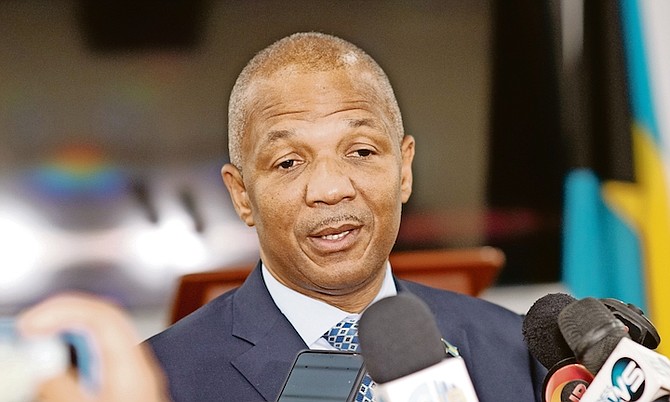By YOURI KEMP
Tribune Business Reporter
ykemp@tribunemedia.net
A Cabinet minister yesterday warned the National Insurance Board (NIB) will lose $95m this year unless contribution rates are raised with the pensions branch alone incurring a monthly $4m deficit.
Myles Laroda, minister of state in the Prime Minister’s Office with responsibility for NIB, speaking ahead of the weekly Cabinet meeting said NIB’s pensions unit stands to pay out $48m more than it earns in 2023 if the average monthly deficit holds.
“The facts are this,” he said. “The NIB will pay out $27m each month in pensions. We’re collecting $23m. That leaves a shortfall of $4m a month. Times 12 and that’s $48m. We’ve not even considered the industrial benefits and other benefits that are being paid out. There are statements that have been made if you go on compliance, if you go and collect the outstanding that is pegged around $30m, that is still only one month of contributions.”
“Some of the issues as it relates to NIB are not things that we can blame anybody for. Can we blame our citizens for living longer? No. So if they are collecting their pension benefits that could be as much as 20 years, when it was about 10 years to 12 years in the beginning. This is where we are.
“We have a situation where next year will make 50 years since NIB has been there. We’ve had one [contribution rate] increase that was in 2010. People are living longer, they’re collecting more benefits. The ceiling has risen from $400 to $700 plus.”
The International Labour Organisation (ILO), in the 11th actuarial report on NIB’s solvency and sustainability, warned there is no choice but to immediately increase contribution rates beyond the existing 9.8 percent otherwise the country’s future may be endangered by the chronic underfunding.
It called for a two percentage point increase in the current NIB contribution rate, split 3.9 percent/5.9 percent between employee and employer, to be implemented from July last year. That recommendation, too, was never taken up by the Government, with the report calling for a series of rolling rate increases every two years through to 2036 to help stabilise and shore up NIB and its $1.5bn reserve fund.
Mr Laroda previously indicated that the Government has taken a decision on NIB although he provided no details. A contribution rate hike, possibly of up to 1.5 percent, is thought likely to be implemented as early as July 2023 although Prime Minister Philip Davis KC was subsequently tight-lipped on whether any raise is forthcoming.
With the Government unable to subsidise NIB, Mr Laroda said: “We have been losing monies from 2016, for the past seven years. Even those cash assets, the CDs (certificates of deposit) that you had, you have to crack those. Why? Because the Government cannot subsidise the National Insurance fund.
“It’s paid for by contribution or investments on rent that’s been collected. So it sounds sexy that everybody has an opinion that one area is causing, whether it be management or whether it be administration costs. That is but a small part of it. I just gave you simple mathematics this month. Some 44,000 people are collecting some form of pension benefits. $27m is going to be paid out; $23m is going to be collected. You do the math. That’s just on the pension and we have a lot of people who are collecting disability benefits and others, and so that’s where we are.”
Among the NIB reform options are raising the “official” retirement age to 67, increasing the contributions required to become eligible for benefits, and further insurable wage ceiling increases. NIB’s present reality was predicted more than two decades by its seventh actuarial review, completed in 2001, which forecast that “reserves are projected to become exhausted” by 2029 if comprehensive reforms are not implemented to stop benefit payouts exceeding contribution income.
NIB itself previously admitted: “NIB further advises that while the reserves of the NIB have grown over the life of the Fund and now stand at $1.5bn, the reserves are currently in a state of decline principally because the amount of benefits paid annually have exceeded the amount of annual contribution income received from 2016.
“Given the current structure of the social security programme, the contribution rate and the number of pensioners receiving benefits, this trend will continue, and the differential between benefits and contributions will increase. For the fiscal year ended December 2021, the benefits payments to the public exceeded the contribution income by $70m.”
Now, with just six years left to the NIB Fund’s total depletion, the magnitude of the correction will be that much more severe for businesses and workers already grappling with surging inflation, COVID recovery, rising gas prices and a potential minimum wage increase. Private sector executives have described the prospect of NIB contribution hikes as a “double” or even “quadruple whammy” for a business community still fighting for “survival”.





Comments
Use the comment form below to begin a discussion about this content.
Commenting has been disabled for this item.